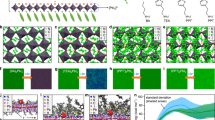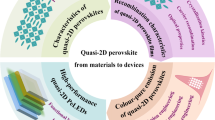Abstract
Perovskite-based optoelectronic devices are gaining much attention owing to their remarkable performance and low processing cost, particularly for solar cells. However, for perovskite light-emitting diodes, non-radiative charge recombination has limited the electroluminescence efficiency. Here we demonstrate perovskite–polymer bulk heterostructure light-emitting diodes exhibiting external quantum efficiencies of up to 20.1% (at current densities of 0.1–1 mA cm−2). The light-emitting diode emissive layer comprises quasi-two-dimensional and three-dimensional (2D/3D) perovskites and an insulating polymer. Photogenerated excitations migrate from quasi-2D to lower-energy sites within 1 ps, followed by radiative bimolecular recombination in the 3D regions. From near-unity external photoluminescence quantum efficiencies and transient kinetics of the emissive layer with and without charge-transport contacts, we find non-radiative recombination pathways to be effectively eliminated, consistent with optical models giving near 100% internal quantum efficiencies. Although the device brightness and stability (T50 = 46 h in air at peak external quantum efficiency) require further improvement, our results indicate the significant potential of perovskite-based photon sources.
This is a preview of subscription content, access via your institution
Access options
Access Nature and 54 other Nature Portfolio journals
Get Nature+, our best-value online-access subscription
$29.99 / 30 days
cancel any time
Subscribe to this journal
Receive 12 print issues and online access
$209.00 per year
only $17.42 per issue
Buy this article
- Purchase on Springer Link
- Instant access to full article PDF
Prices may be subject to local taxes which are calculated during checkout





Similar content being viewed by others
Data availability
The data that support the plots within this paper and other findings of this study are available in the University of Cambridge Repository (https://doi.org/10.17863/CAM.30616). Related research results are available from the corresponding authors upon reasonable request.
References
Kojima, A., Teshima, K., Shirai, Y. & Miyasaka, T. Organometal halide perovskites as visible-light sensitizers for photovoltaic cells. J. Am. Chem. Soc. 131, 6050–6051 (2009).
Lee, M. M., Teuscher, J., Miyasaka, T., Murakami, T. N. & Snaith, H. J. Efficient hybrid solar cells based on meso-superstructured organometal halide perovskites. Science 338, 643–647 (2012).
Kim, H.-S. et al. Lead iodide perovskite sensitized all-solid-state submicron thin film mesoscopic solar cell with efficiency exceeding 9%. Sci. Rep. 2, 591 (2012).
Green, M. A., Ho-Baillie, A. & Snaith, H. J. The emergence of perovskite solar cells. Nat. Photon. 8, 506–514 (2014).
Tan, Z.-K. et al. Bright light-emitting diodes based on organometal halide perovskite. Nat. Nanotech. 9, 687–692 (2014).
Cho, H. et al. Overcoming the electroluminescence efficiency limitations of perovskite light-emitting diodes. Science 350, 1222–1225 (2015).
Yuan, M. et al. Perovskite energy funnels for efficient light-emitting diodes. Nat. Nanotech. 11, 872–877 (2016).
Wang, N. et al. Perovskite light-emitting diodes based on solution-processed self-organized multiple quantum wells. Nat. Photon. 10, 699–704 (2016).
Deschler, F. et al. High photoluminescence efficiency and optically pumped lasing in solution-processed mixed halide perovskite semiconductors. J. Phys. Chem. Lett. 5, 1421–1426 (2014).
Xing, G. et al. Low-temperature solution-processed wavelength-tunable perovskites for lasing. Nat. Mater. 13, 476–480 (2014).
Dou, L. et al. Solution-processed hybrid perovskite photodetectors with high detectivity. Nat. Commun. 5, 5404 (2014).
Fang, Y., Dong, Q., Shao, Y., Yuan, Y. & Huang, J. Highly narrowband perovskite single-crystal photodetectors enabled by surface-charge recombination. Nat. Photon. 9, 679–686 (2015).
Yang, X. et al. Efficient green light-emitting diodes based on quasi-two-dimensional composition and phase engineered perovskite with surface passivation. Nat. Commun. 9, 570 (2018).
Reineke, S. et al. White organic light-emitting diodes with fluorescent tube efficiency. Nature 459, 234–238 (2009).
Uoyama, H., Goushi, K., Shizu, K., Nomura, H. & Adachi, C. Highly efficient organic light-emitting diodes from delayed fluorescence. Nature 492, 234–238 (2012).
Di, D. et al. High-performance light-emitting diodes based on carbene-metal-amides. Science 356, 159–163 (2017).
Ball, J. M. & Petrozza, A. Defects in perovskite-halides and their effects in solar cells. Nat. Energy 1, 16149 (2016).
Ross, R. T. Some thermodynamics of photochemical systems. J. Chem. Phys. 46, 4590–4593 (1967).
Shockley, W. & Queisser, H. J. Detailed balance limit of efficiency of p–n junction solar cells. J. Appl. Phys. 32, 510–519 (1961).
Yablonovitch, E. Lead halides join the top optoelectronic league. Science 351, 1401 (2016).
Di, D. et al. Size-dependent photon emission from organometal halide perovskite nanocrystals embedded in an organic matrix. J. Phys. Chem. Lett. 6, 446–450 (2015).
Li, G. et al. Efficient light-emitting diodes based on nanocrystalline perovskite in a dielectric polymer matrix. Nano Lett. 15, 2640–2644 (2015).
Xiao, Z. et al. Efficient perovskite light-emitting diodes featuring nanometre-sized crystallites. Nat. Photon. 11, 108–115 (2017).
Weller, M. T., Weber, O. J., Frost, J. M. & Walsh, A. Cubic perovskite structure of black formamidinium lead iodide, α-[HC(NH2)2]PbI3, at 298 K. J. Phys. Chem. Lett. 6, 3209–3212 (2015).
Wang, J. et al. Interfacial control toward efficient and low-voltage perovskite light-emitting diodes. Adv. Mater. 27, 2311–2316 (2015).
Dai, X. et al. Solution-processed, high-performance light-emitting diodes based on quantum dots. Nature 515, 96–99 (2014).
Yang, Y. et al. Top and bottom surfaces limit carrier lifetime in lead iodide perovskite films. Nat. Energy 2, 16207 (2017).
Saba, M. et al. Correlated electron–hole plasma in organometal perovskites. Nat. Commun. 5, 5049 (2014).
Richter, J. M. et al. Enhancing photoluminescence yields in lead halide perovskites by photon recycling and light out-coupling. Nat. Commun. 7, 13941 (2016).
Pazos-Outón, L. M. et al. Photon recycling in lead iodide perovskite solar cells. Science 351, 1430–1433 (2016).
Shi, D. et al. Low trap-state density and long carrier diffusion in organolead trihalide perovskite single crystals. Science 347, 519–522 (2015).
Brenner, T. M., Egger, D. A., Kronik, L., Hodes, G. & Cahen, D. Hybrid organic–inorganic perovskites: low-cost semiconductors with intriguing charge-transport properties. Nat. Rev. Mater. 1, 15007 (2016).
Bai, S. et al. High-performance planar heterojunction perovskite solar cells: preserving long charge carrier diffusion lengths and interfacial engineering. Nano Res. 7, 1749–1758 (2014).
Zhou, Y. et al. A universal method to produce low-work function electrodes for organic electronics. Science 336, 327–332 (2012).
Greenham, N. C., Friend, R. H. & Bradley, D. D. C. Angular dependence of the emission from a conjugated polymer light-emitting diode: implications for efficiency calculations. Adv. Mater. 6, 491–494 (1994).
Forrest, S. R., Bradley, D. D. C. & Thompson, M. E. Measuring the efficiency of organic light-emitting devices. Adv. Mater. 15, 1043–1048 (2003).
de Mello, J. C., Wittmann, H. F. & Friend, R. H. An improved experimental determination of external photoluminescence quantum efficiency. Adv. Mater. 9, 230–232 (1997).
Di, D. et al. Efficient triplet exciton fusion in molecularly doped polymer light-emitting diodes. Adv. Mater. 29, 1605987 (2017).
Wallikewitz, B. H., Kabra, D., Gélinas, S. & Friend, R. H. Triplet dynamics in fluorescent polymer light-emitting diodes. Phys. Rev. B 85, 45209 (2012).
Chen, K., Gallaher, J. K., Barker, A. J. & Hodgkiss, J. M. Transient grating photoluminescence spectroscopy: an ultrafast method of gating broadband spectra. J. Phys. Chem. Lett. 5, 1732–1737 (2014).
Jakowetz, A. C. et al. What controls the rate of ultrafast charge transfer and charge separation efficiency in organic photovoltaic blends. J. Am. Chem. Soc. 138, 11672–11679 (2016).
Xu, X., Goponenko, A. V. & Asher, S. A. Polymerized polyHEMA photonic crystals: pH and ethanol sensor materials. J. Am. Chem. Soc. 130, 3113–3119 (2008).
Neyts, K. A. Simulation of light emission from thin-film microcavities. J. Opt. Soc. Am. A 15, 962 (1998).
Benisty, H., Stanley, R. & Mayer, M. Method of source terms for dipole emission modification in modes of arbitrary planar structures. J. Opt. Soc. Am. A 15, 1192 (1998).
Defrance, J. et al. Moosh: a numerical Swiss army knife for the optics of multilayers in Octave/Matlab. J. Open Res. Softw. 4, e13 (2016).
Acknowledgements
B.Z. thanks the Cambridge Trust and China Scholarship Council for funding and support. S.B. is supported by a VINNMER Marie-Curie Fellowship. R.S. acknowledges support from the Royal Society Newton-Bhabha International Fellowship. M.A. acknowledges support from the President of the UAE’s Distinguished Student Scholarship Program (DSS), granted by the UAE’s Ministry of Presidential Affairs. XMaS is a mid-range facility supported by the Engineering and Physical Sciences Research Council (EPSRC). The authors thank all the XMaS beamline team staff for their support. P.G. thanks the ‘Thousand Talent Program’ for support. D.D. and R.H.F. thank the EPSRC for support. The research leading to these results has received funding from the European Research Council (ERC) under the European Union’s Horizon 2020 research and innovation programme (grant agreement no. 670405).
Author information
Authors and Affiliations
Contributions
B.Z. and D.D. developed and characterized the high-efficiency LEDs. D.D., B.Z. and L.Y. carried out the nano- to microsecond transient photoluminescence and electroluminescence studies. V.K. conducted the transient absorption experiments. J.M.R. performed the femto- to picosecond transient photoluminescence measurements. R.L. developed the optical model for the LED devices under the guidance of N.C.G. S.B. synthesised the MZO nanocrystals, tailored the MZO properties, and contributed to LED development. R.S. carried out the lateral photoluminescence experiments. F.A., L.L. and P.G. synthesized the perovskite precursors. L.D. performed the HR-TEM and atomic force microscopy measurements. X.-J.S. and B.Z. performed the SEM studies. F.A., M.A., P.G. and B.Z. carried out the XRD analysis. J.Z. helped with some transient measurements and PLQE calculations. D.D. and B.Z. analysed all the results and wrote the manuscript, which was revised by R.H.F. All authors contributed to the work and commented on the paper. D.D. planned the project and guided the work, with R.H.F.
Corresponding authors
Ethics declarations
Competing interests
R.H.F., H.J.S. and N.C.G. are co-founders of Heliochrome Ltd.
Additional information
Publisher’s note: Springer Nature remains neutral with regard to jurisdictional claims in published maps and institutional affiliations.
Supplementary information
Supplementary Information
Additional data for chemical structure, morphology and device characterization
Rights and permissions
About this article
Cite this article
Zhao, B., Bai, S., Kim, V. et al. High-efficiency perovskite–polymer bulk heterostructure light-emitting diodes. Nature Photon 12, 783–789 (2018). https://doi.org/10.1038/s41566-018-0283-4
Received:
Accepted:
Published:
Issue Date:
DOI: https://doi.org/10.1038/s41566-018-0283-4
This article is cited by
-
New nanostructure perovskite-based light-emitting diode with superior light extraction efficiency enhancement
Scientific Reports (2024)
-
Potential and perspectives of halide perovskites in light emitting devices
Nano Convergence (2023)
-
Synthesis of 2D perovskite crystals via progressive transformation of quantum well thickness
Nature Synthesis (2023)
-
Large-area waterproof and durable perovskite luminescent textiles
Nature Communications (2023)
-
Understanding the influence of cation and anion migration on perovskite light-emitting diodes via transient response
Scientific Reports (2023)



